Working with trajectories
This example is also available as a Jupyter notebook: trajectories.ipynb, and as an executable julia file trajectories.jl.
In the following, we demonstrate how to use coherent structure detection methods that work directly on trajectory data sets. These include the graph Laplace-based and the transfer operator-based methods for approximating the dynamic Laplacian. For simplicity, we will demonstrate the methods based on trajectories obtained from integrating the Bickley jet velocity field.
Graph Laplace-based methods
In the following, we demonstrate how to apply several graph Laplace-based coherent structure detection methods. For references and technical details, we refer to the corresponding Graph Laplacian/diffusion maps-based LCS methods page.
As an example, this is how we can add more processes to run code in parallel.
using Distributed
(nprocs() == 1) && addprocs()We first load our package, some dependencies, and define the vector field.
@everywhere using CoherentStructures, StreamMacros
using Distances, Plots
const bickleyJet = @velo_from_stream psi begin
psi = psi₀ + psi₁
psi₀ = - U₀ * L₀ * tanh(y / L₀)
psi₁ = U₀ * L₀ * sech(y / L₀)^2 * re_sum_term
re_sum_term = Σ₁ + Σ₂ + Σ₃
Σ₁ = ε₁ * cos(k₁*(x - c₁*t))
Σ₂ = ε₂ * cos(k₂*(x - c₂*t))
Σ₃ = ε₃ * cos(k₃*(x - c₃*t))
k₁ = 2/r₀ ; k₂ = 4/r₀ ; k₃ = 6/r₀
ε₁ = 0.0075 ; ε₂ = 0.15 ; ε₃ = 0.3
c₂ = 0.205U₀ ; c₃ = 0.461U₀; c₁ = c₃ + (√5-1)*(c₂-c₃)
U₀ = 62.66e-6; L₀ = 1770e-3; r₀ = 6371e-3
endNext, we define the usual flow parameters. For visualization convenience, we use a regular grid at initial time.
const tspan = range(10*24*3600.0, stop=30*24*3600.0, length=41)
m = 120; n = 41; N = m*n
x = range(0.0, stop=20.0, length=m)
y = range(-3.0, stop=3.0, length=n)
f = u -> flow(bickleyJet, u, tspan, tolerance=1e-4)
particles = vec(tuple.(x, y'))
trajectories = pmap(f, particles; batch_size=ceil(Int, N/nprocs()^2))The flow is defined on a cylinder with the following periods in x and y. The variable metric defines the (spatial) distance metric.
periods = [6.371π, Inf]
metric = PeriodicEuclidean(periods)We would like calculate 6 diffusion coordinates for each example.
n_coords = 6We now illustrate some of the different graph Laplace-based methods, and simply visualize some eigenvectors, mostly without further postprocessing.
Spectral-clustering approach/L_1 time averaging [Hadjighasem, Karrasch, Teramoto & Haller, 2016]
ε = 1.0
kernel = gaussian(ε)
P = sparse_diff_op(trajectories, Neighborhood(gaussiancutoff(ε/20)), kernel; metric=STmetric(metric, 1))
λ, Ψ = diffusion_coordinates(P, n_coords)We plot the second and third eigenvectors.
field = permutedims(reshape(Ψ[:, 2], m, n))
fig = Plots.heatmap(x, y, field, aspect_ratio=1, color=:viridis)
field = permutedims(reshape(Ψ[:, 3], m, n))
fig = Plots.heatmap(x, y, field, aspect_ratio=1, color=:viridis)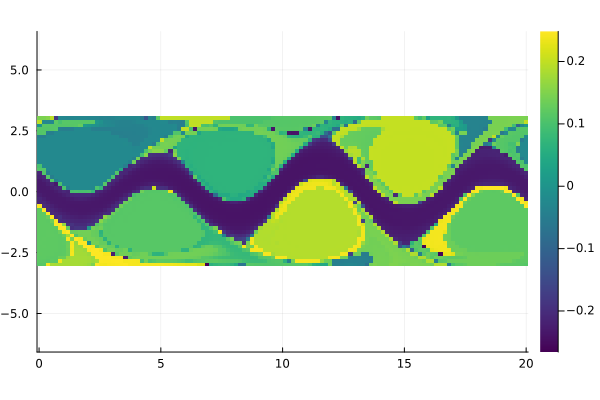
Another sparsification option is k-nearest neighbors. The following is a demonstration for 400 nearest, non-mutual neighbors. For the mutual nearest neighbors sparsification, choose MutualKNN().
P = sparse_diff_op(trajectories, KNN(200), gaussian(10); metric=STmetric(metric, Inf))
λ, Ψ = diffusion_coordinates(P, n_coords)
field = permutedims(reshape(Ψ[:, 2], m, n))
fig = Plots.heatmap(x, y, field, aspect_ratio=1, color=:viridis)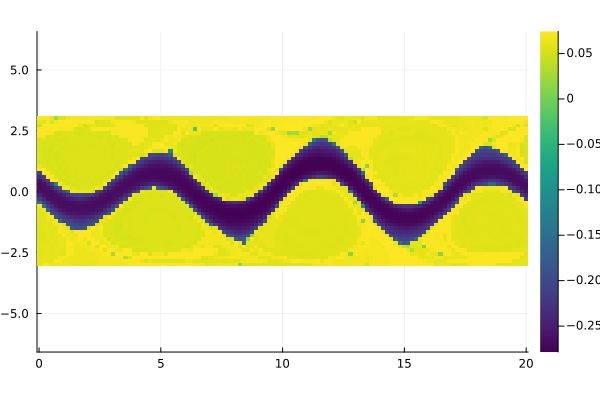
field = permutedims(reshape(Ψ[:, 3], m, n))
fig = Plots.heatmap(x, y, field, aspect_ratio=1, color=:viridis)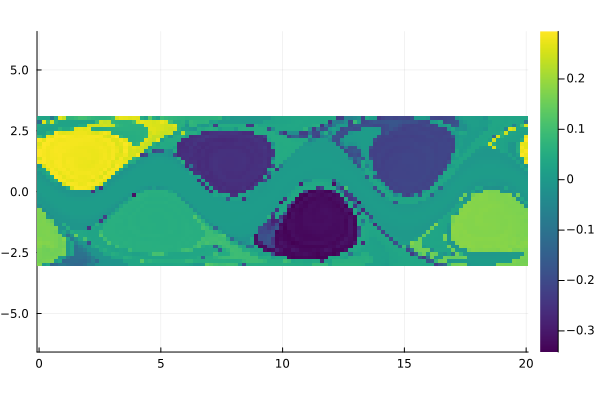
Use of SEBA to extract features
For feature extraction from operator eigenvectors, one may use the "SEBA" method developed by [Froyland, Rock & Sakellariou, 2019].
Ψ2 = SEBA(Ψ)We plot two of the SEBA features extracted.
field = permutedims(reshape(Ψ2[:, 1], m, n))
fig = Plots.heatmap(x, y, field, aspect_ratio=1, color=:viridis)
field = permutedims(reshape(Ψ2[:, 2], m, n))
fig = Plots.heatmap(x, y, field, aspect_ratio=1, color=:viridis)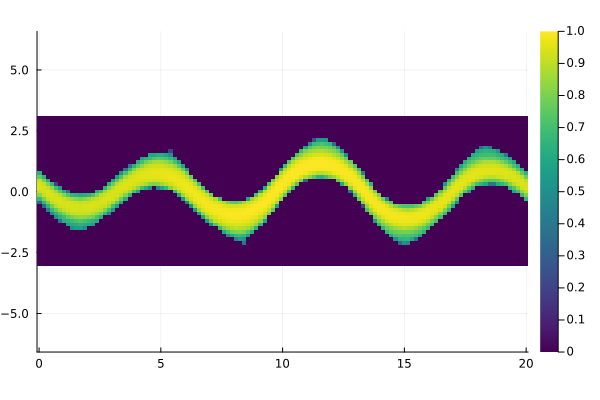
Space-time diffusion maps [Banisch & Koltai, 2017]
import Statistics: mean
σ = 1e-3
kernel = gaussian(σ)
P = sparse_diff_op_family(trajectories, Neighborhood(gaussiancutoff(σ)), kernel, mean; metric=metric)
λ, Ψ = diffusion_coordinates(P, n_coords)
field = permutedims(reshape(Ψ[:, 2], m, n))
fig = Plots.heatmap(x, y, field, aspect_ratio=1, color=:viridis)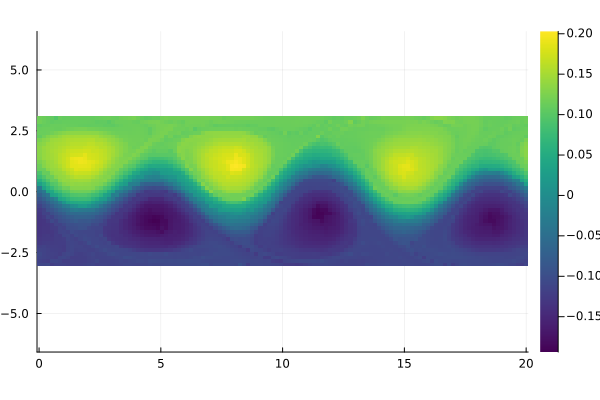
field = permutedims(reshape(Ψ[:, 3], m, n))
fig = Plots.heatmap(x, y, field, aspect_ratio=1, color=:viridis)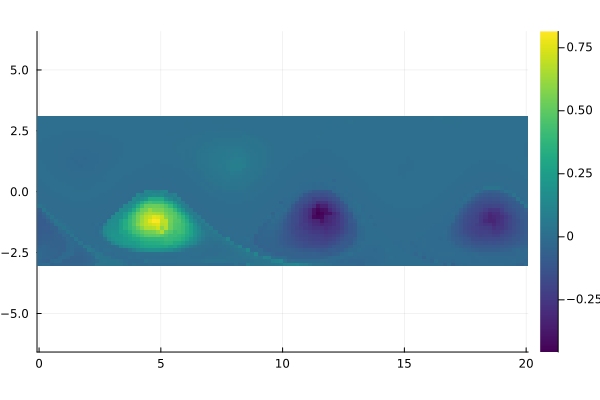
Network-based approach [Padberg-Gehle & Schneide, 2017]
ε = 0.2
P = sparse_diff_op_family(trajectories, Neighborhood(ε), Base.one, row_normalize!∘unionadjacency;
α=0, metric=metric)
λ, Ψ = diffusion_coordinates(P, n_coords)
field = permutedims(reshape(Ψ[:, 2], m, n))
fig = Plots.heatmap(x, y, field, aspect_ratio=1, color=:viridis)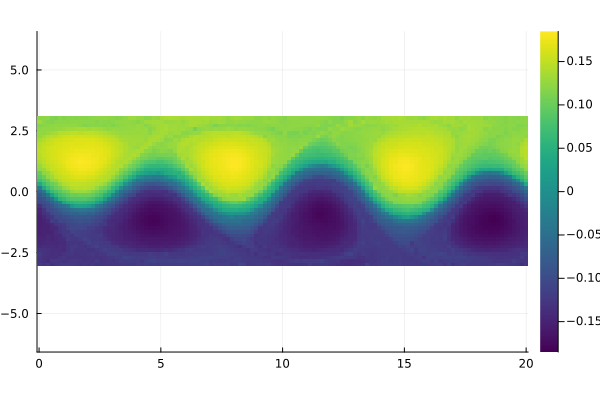
field = permutedims(reshape(Ψ[:, 3], m, n))
fig = Plots.heatmap(x, y, field, aspect_ratio=1, color=:viridis)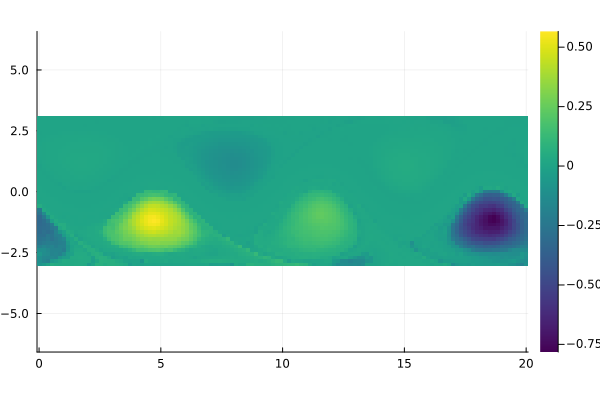
Time coupled diffusion coordinates [Marshall & Hirn, 2018]
σ = 1e-3
kernel = gaussian(σ)
P = sparse_diff_op_family(trajectories, Neighborhood(gaussiancutoff(σ)), kernel; metric=metric)
λ, Ψ = diffusion_coordinates(P, n_coords)
field = permutedims(reshape(Ψ[:, 2], m, n))
fig = Plots.heatmap(x, y, field, aspect_ratio=1, color=:viridis)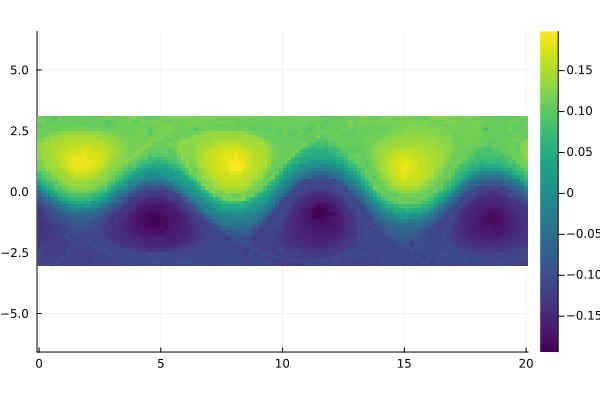
field = permutedims(reshape(Ψ[:, 3], m, n))
fig = Plots.heatmap(x, y, field, aspect_ratio=1, color=:viridis)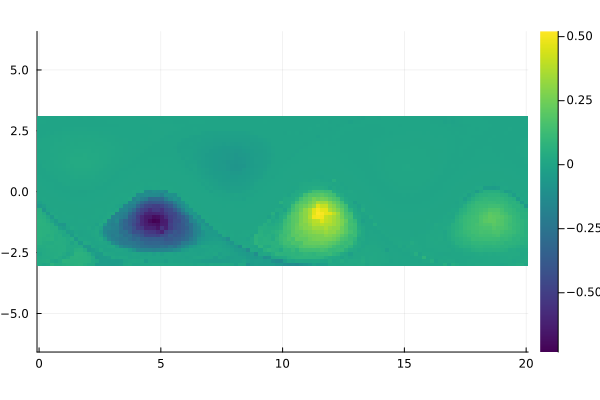
FEM adaptive TO method
We first generate some trajectories on a set of n random points for the rotating double gyre flow.
using StreamMacros, CoherentStructures, Random, Plots, Clustering
const rot_double_gyre = @velo_from_stream Ψ_rot_dgyre begin
st = heaviside(t)*heaviside(1-t)*t^2*(3-2*t) + heaviside(t-1)
heaviside(x)= 0.5*(sign(x) + 1)
Ψ_P = sin(2π*x)*sin(π*y)
Ψ_F = sin(π*x)*sin(2π*y)
Ψ_rot_dgyre = (1-st) * Ψ_P + st * Ψ_F
end
n = 500
ts = range(0, stop=1.0, length=20)
Random.seed!(1234)
xs, ys = rand(n), rand(n)
particles = zip(xs, ys)
trajectories = [flow(rot_double_gyre, p, ts) for p in particles]Based on the initial particle positions we generate a triangulation. If this call fails or does not return, the initial positions may not be unique. In that case, simply generate a different set of random initial positions.
ctx, _ = irregularDelaunayGrid(particles)Next, we generate the stiffness and mass matrices and solve the generalized eigenproblem.
S = adaptiveTOCollocationStiffnessMatrix(ctx, (i, ts) -> trajectories[i], ts; flow_map_mode=1)
M = assembleMassMatrix(ctx)
λ, V = CoherentStructures.get_smallest_eigenpairs(S, M, 6)We can plot the computed spectrum.
fig = plot_real_spectrum(λ, label="")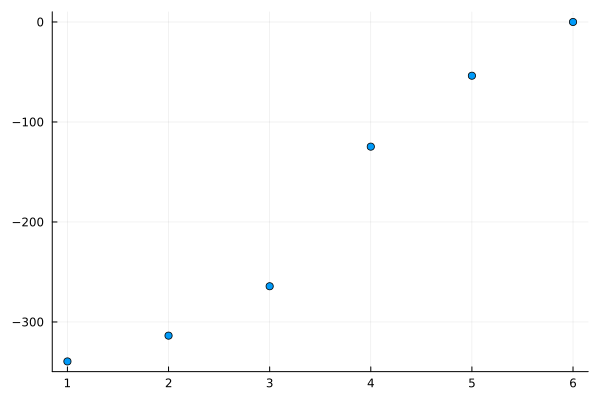
We may extract coherent vortices with k-means clustering.
function iterated_kmeans(iterations, args...)
best = kmeans(args...)
for i in 1:(iterations - 1)
cur = kmeans(args...)
if cur.totalcost < best.totalcost
best = cur
end
end
return best.assignments
end
partitions = 3
clusters = iterated_kmeans(20, permutedims(V[:, 2:partitions]), partitions)A simple scatter plot visualization looks as follows.
fig = scatter(xs, ys, zcolor=clusters[ctx.node_to_dof], markersize=8, labels="")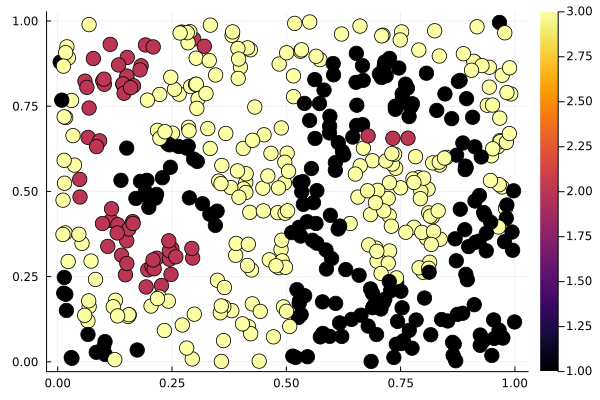
Alternatively, we may also plot the cluster assignments on the whole irregular grid.
fig = plot_u(ctx, float(clusters), 400, 400;
color=:viridis,
colorbar=:none,
title="$partitions-partition of rotating double gyre")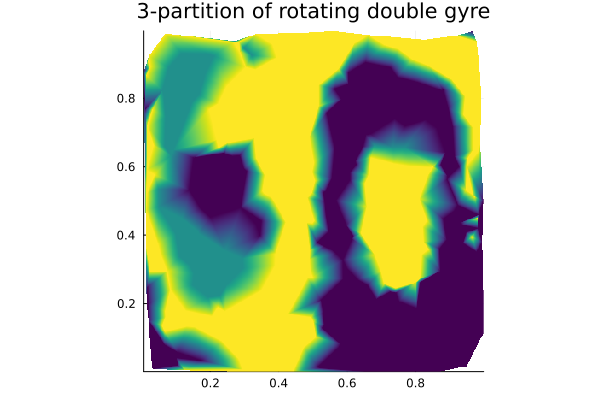
This page was generated using Literate.jl.